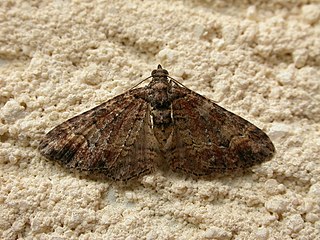
Arotrophora is a genus of tortrix moth. They occur in Australia, where they are strongly associated with the plant family Proteaceae. All of the known Australian larvae bore in Banksia flower spikes. The genus was recently discovered from the Oriental region and one species is found on Papua.

Alfred Jefferis Turner was a pediatrician and noted amateur entomologist. He was the son of missionary Frederick Storrs-Turner. He introduced the use of diphtheria antitoxin to Australia in 1895. He was known by the nickname "Gentle Annie".
Heliosia is a genus of moths in the family Erebidae erected by George Hampson in 1900.
Homospora is a monotypic moth genus in the family Geometridae described by Turner in 1904. Its only species, Homospora rhodoscopa, was first described by Oswald Bertram Lower in 1902. It is found in Australia.

Scotocyma is a genus of moths in the family Geometridae described by Turner in 1904. All the species in this genus are found in Australia.

Stictea is a genus of moths belonging to the subfamily Olethreutinae of the family Tortricidae.

Chrysolarentia plesia, the plesia carpet, is a moth of the family Geometridae first described by Alfred Jefferis Turner in 1904. It is found in the Australian states of Victoria and Western Australia.

Chrysolarentia plagiocausta, the black-lined carpet, is a moth of the family Geometridae first described by Alfred Jefferis Turner in 1904. It is found in the Australian Capital Territory, Tasmania and Victoria.
Gymnoscelis lophopus is a moth in the family Geometridae. It was described Turner in 1904. It is found in Queensland, Australia.
Heliosia alba is a moth of the family Erebidae. It was described by George Hampson in 1914. It is found in Taiwan.
Heliosia atriplaga is a moth of the family Erebidae. It was described by George Hampson in 1914. It is found on the Loyalty Islands in the south-west Pacific.
Heliosia jucunda is a moth of the family Erebidae. It was described by Francis Walker in 1854. It is found in the Australian states of Queensland and New South Wales.
Heliosia micra is a moth of the family Erebidae. It was described by George Hampson in 1903. It is found in Australia.
Heliosia monosticta is a moth of the family Erebidae. It was described by George Hampson in 1900. It is found on Borneo. The habitat consists of lowland forests, dry heath forests and coastal scrubs.
Heliosia perichares is a moth of the family Erebidae. It was described by Alfred Jefferis Turner in 1944. It is found in Australia, where it has been recorded from Queensland and New South Wales.
Heliosia punctinigra is a moth of the family Erebidae. It was described by Rudolf van Eecke in 1920. It is found on Java in Indonesia.
Heliosia rufa is a moth of the family Erebidae. It was described by John Henry Leech in 1890. It is found in the Russian Far East (Primorye) and China.
The Nudariina are a subtribe of lichen moths in the family Erebidae. The taxon was described by Carl Julius Bernhard Börner in 1920.





